FIN200 Assignment: Factors in Choosing a Superannuation Plan Type
VerifiedAdded on 2023/06/11
|10
|2584
|379
Essay
AI Summary
This essay explores the important factors that tertiary sector employees should consider when deciding whether to place their superannuation contributions in a Defined Benefit Plan or an Investment Choice Plan. It contrasts the two plans, highlighting the advantages and disadvantages of each. Factors such as comfort with investing, duration of employment, family circumstances, prevailing economic conditions, company requirements, rate of return on investment, and employee salary are discussed. The essay also delves into financial management concepts like the time value of money, tax implications, and the impact of interest rates on each plan. It concludes that engaging a financial management professional is crucial for making an informed decision that aligns with individual circumstances and future financial needs.
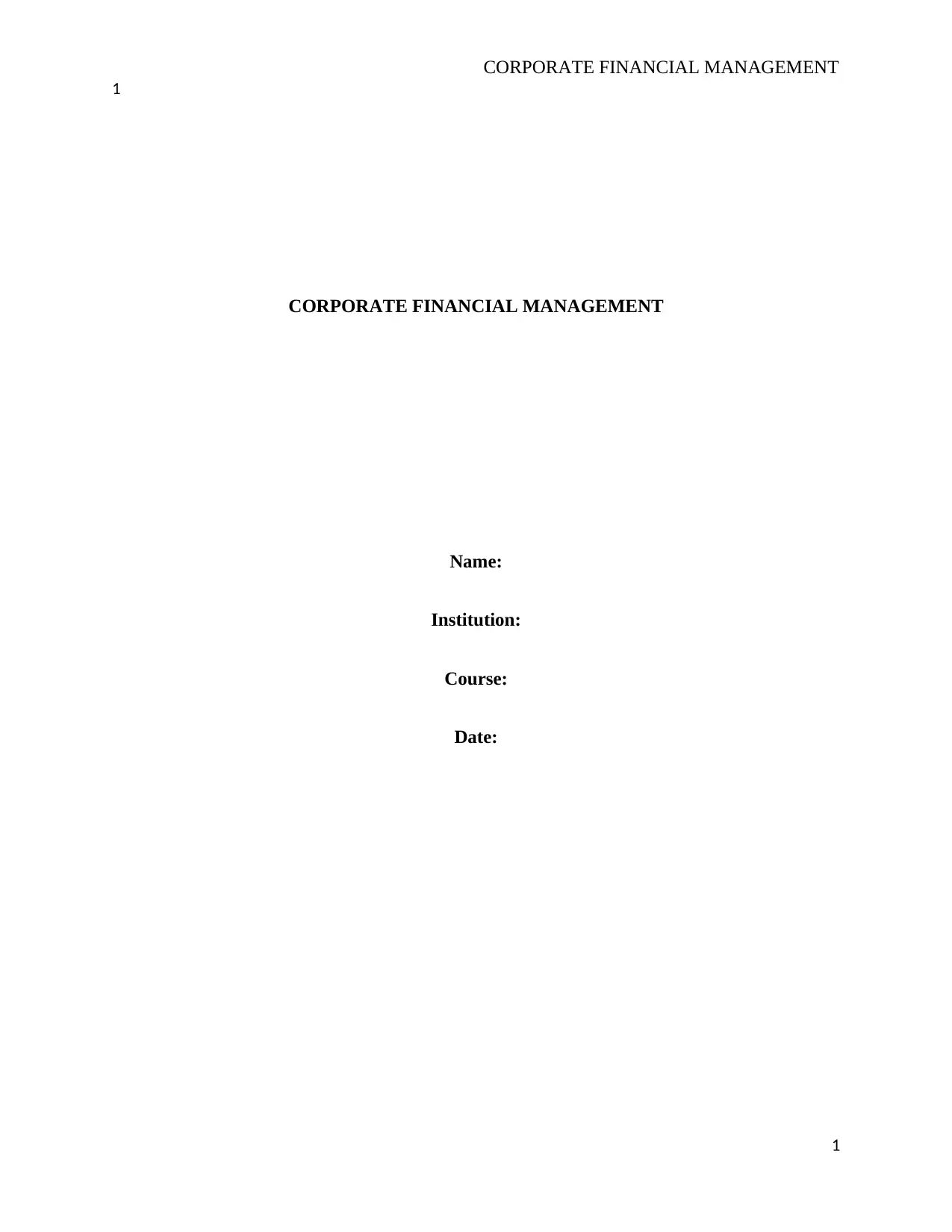
CORPORATE FINANCIAL MANAGEMENT
1
CORPORATE FINANCIAL MANAGEMENT
Name:
Institution:
Course:
Date:
1
1
CORPORATE FINANCIAL MANAGEMENT
Name:
Institution:
Course:
Date:
1
Paraphrase This Document
Need a fresh take? Get an instant paraphrase of this document with our AI Paraphraser
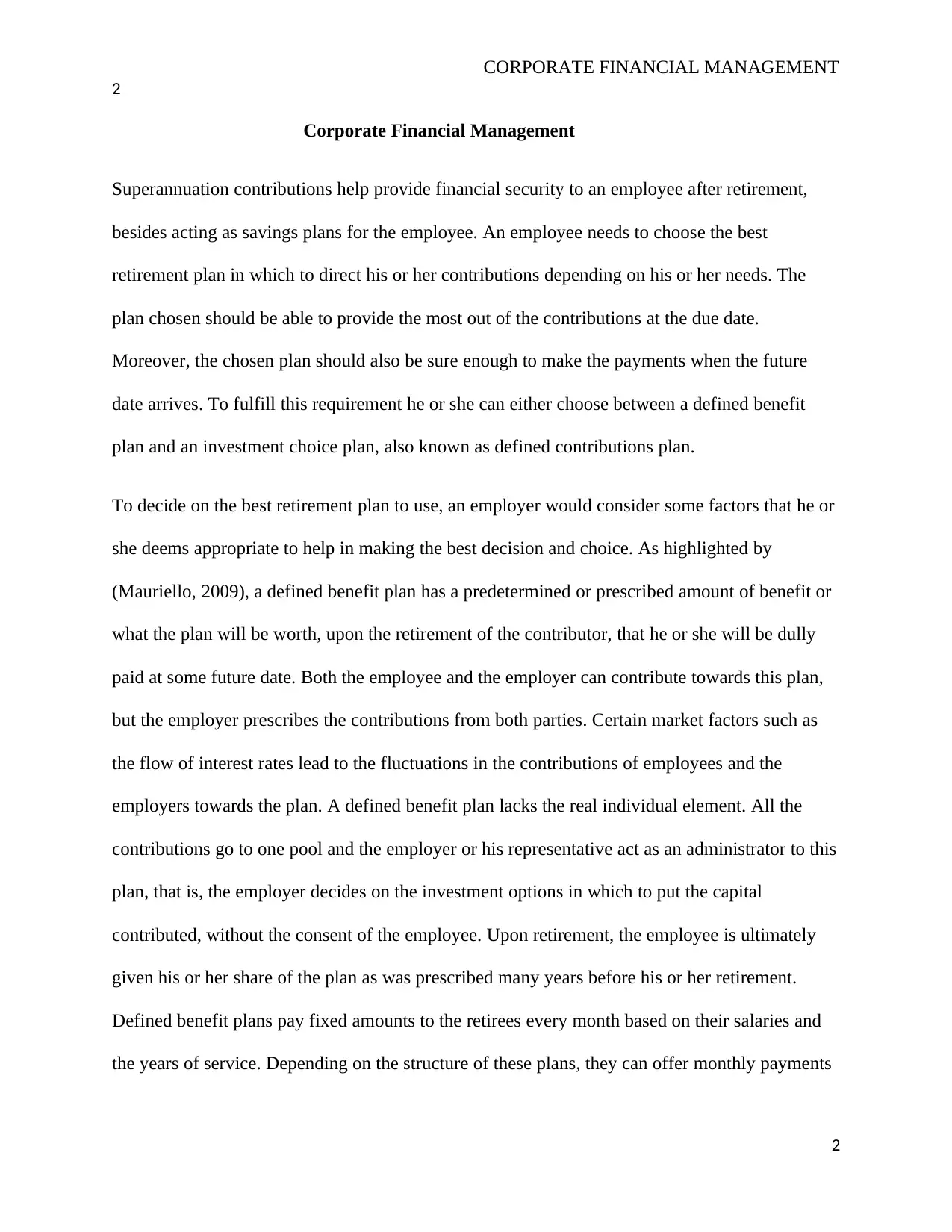
CORPORATE FINANCIAL MANAGEMENT
2
Corporate Financial Management
Superannuation contributions help provide financial security to an employee after retirement,
besides acting as savings plans for the employee. An employee needs to choose the best
retirement plan in which to direct his or her contributions depending on his or her needs. The
plan chosen should be able to provide the most out of the contributions at the due date.
Moreover, the chosen plan should also be sure enough to make the payments when the future
date arrives. To fulfill this requirement he or she can either choose between a defined benefit
plan and an investment choice plan, also known as defined contributions plan.
To decide on the best retirement plan to use, an employer would consider some factors that he or
she deems appropriate to help in making the best decision and choice. As highlighted by
(Mauriello, 2009), a defined benefit plan has a predetermined or prescribed amount of benefit or
what the plan will be worth, upon the retirement of the contributor, that he or she will be dully
paid at some future date. Both the employee and the employer can contribute towards this plan,
but the employer prescribes the contributions from both parties. Certain market factors such as
the flow of interest rates lead to the fluctuations in the contributions of employees and the
employers towards the plan. A defined benefit plan lacks the real individual element. All the
contributions go to one pool and the employer or his representative act as an administrator to this
plan, that is, the employer decides on the investment options in which to put the capital
contributed, without the consent of the employee. Upon retirement, the employee is ultimately
given his or her share of the plan as was prescribed many years before his or her retirement.
Defined benefit plans pay fixed amounts to the retirees every month based on their salaries and
the years of service. Depending on the structure of these plans, they can offer monthly payments
2
2
Corporate Financial Management
Superannuation contributions help provide financial security to an employee after retirement,
besides acting as savings plans for the employee. An employee needs to choose the best
retirement plan in which to direct his or her contributions depending on his or her needs. The
plan chosen should be able to provide the most out of the contributions at the due date.
Moreover, the chosen plan should also be sure enough to make the payments when the future
date arrives. To fulfill this requirement he or she can either choose between a defined benefit
plan and an investment choice plan, also known as defined contributions plan.
To decide on the best retirement plan to use, an employer would consider some factors that he or
she deems appropriate to help in making the best decision and choice. As highlighted by
(Mauriello, 2009), a defined benefit plan has a predetermined or prescribed amount of benefit or
what the plan will be worth, upon the retirement of the contributor, that he or she will be dully
paid at some future date. Both the employee and the employer can contribute towards this plan,
but the employer prescribes the contributions from both parties. Certain market factors such as
the flow of interest rates lead to the fluctuations in the contributions of employees and the
employers towards the plan. A defined benefit plan lacks the real individual element. All the
contributions go to one pool and the employer or his representative act as an administrator to this
plan, that is, the employer decides on the investment options in which to put the capital
contributed, without the consent of the employee. Upon retirement, the employee is ultimately
given his or her share of the plan as was prescribed many years before his or her retirement.
Defined benefit plans pay fixed amounts to the retirees every month based on their salaries and
the years of service. Depending on the structure of these plans, they can offer monthly payments
2
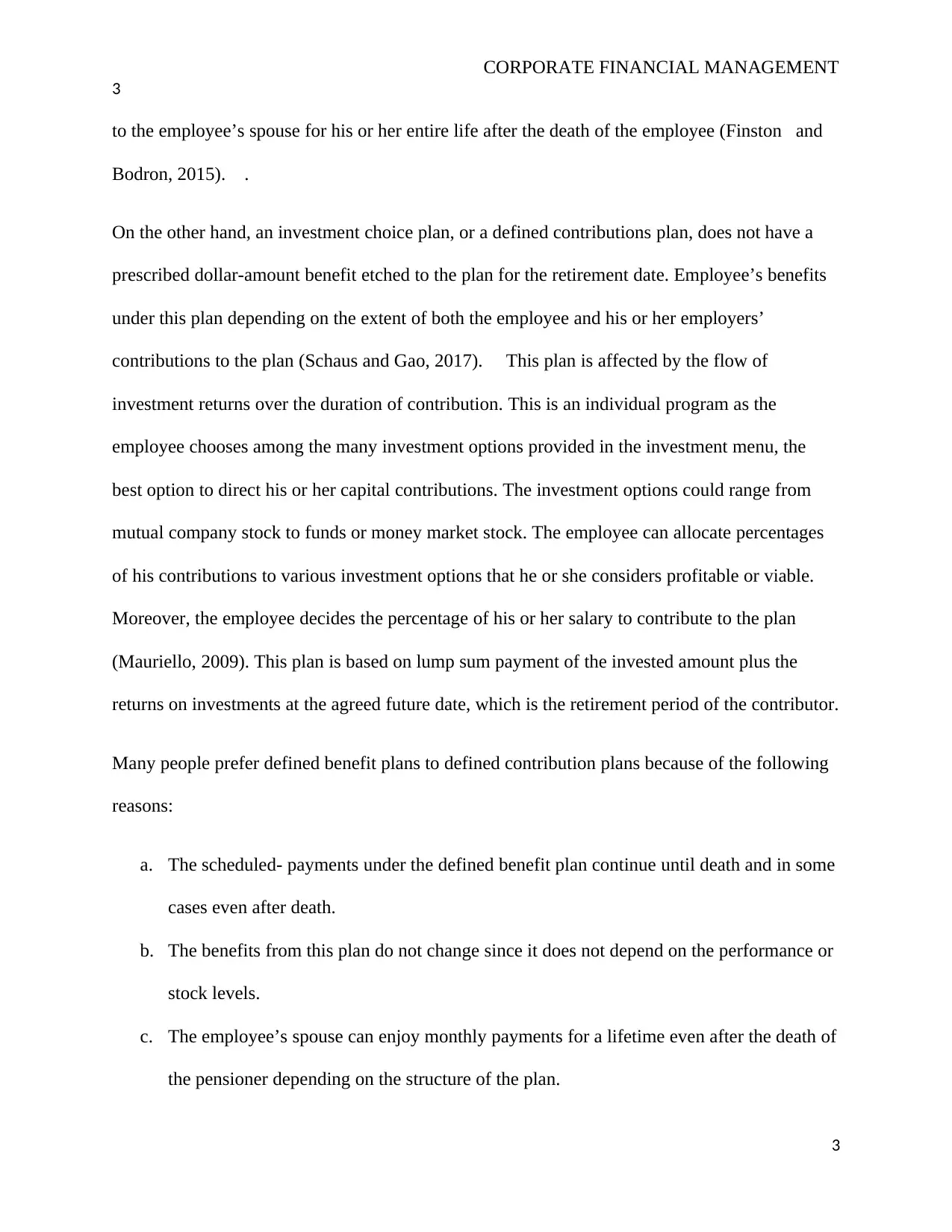
CORPORATE FINANCIAL MANAGEMENT
3
to the employee’s spouse for his or her entire life after the death of the employee (Finston and
Bodron, 2015). .
On the other hand, an investment choice plan, or a defined contributions plan, does not have a
prescribed dollar-amount benefit etched to the plan for the retirement date. Employee’s benefits
under this plan depending on the extent of both the employee and his or her employers’
contributions to the plan (Schaus and Gao, 2017). This plan is affected by the flow of
investment returns over the duration of contribution. This is an individual program as the
employee chooses among the many investment options provided in the investment menu, the
best option to direct his or her capital contributions. The investment options could range from
mutual company stock to funds or money market stock. The employee can allocate percentages
of his contributions to various investment options that he or she considers profitable or viable.
Moreover, the employee decides the percentage of his or her salary to contribute to the plan
(Mauriello, 2009). This plan is based on lump sum payment of the invested amount plus the
returns on investments at the agreed future date, which is the retirement period of the contributor.
Many people prefer defined benefit plans to defined contribution plans because of the following
reasons:
a. The scheduled- payments under the defined benefit plan continue until death and in some
cases even after death.
b. The benefits from this plan do not change since it does not depend on the performance or
stock levels.
c. The employee’s spouse can enjoy monthly payments for a lifetime even after the death of
the pensioner depending on the structure of the plan.
3
3
to the employee’s spouse for his or her entire life after the death of the employee (Finston and
Bodron, 2015). .
On the other hand, an investment choice plan, or a defined contributions plan, does not have a
prescribed dollar-amount benefit etched to the plan for the retirement date. Employee’s benefits
under this plan depending on the extent of both the employee and his or her employers’
contributions to the plan (Schaus and Gao, 2017). This plan is affected by the flow of
investment returns over the duration of contribution. This is an individual program as the
employee chooses among the many investment options provided in the investment menu, the
best option to direct his or her capital contributions. The investment options could range from
mutual company stock to funds or money market stock. The employee can allocate percentages
of his contributions to various investment options that he or she considers profitable or viable.
Moreover, the employee decides the percentage of his or her salary to contribute to the plan
(Mauriello, 2009). This plan is based on lump sum payment of the invested amount plus the
returns on investments at the agreed future date, which is the retirement period of the contributor.
Many people prefer defined benefit plans to defined contribution plans because of the following
reasons:
a. The scheduled- payments under the defined benefit plan continue until death and in some
cases even after death.
b. The benefits from this plan do not change since it does not depend on the performance or
stock levels.
c. The employee’s spouse can enjoy monthly payments for a lifetime even after the death of
the pensioner depending on the structure of the plan.
3
⊘ This is a preview!⊘
Do you want full access?
Subscribe today to unlock all pages.

Trusted by 1+ million students worldwide
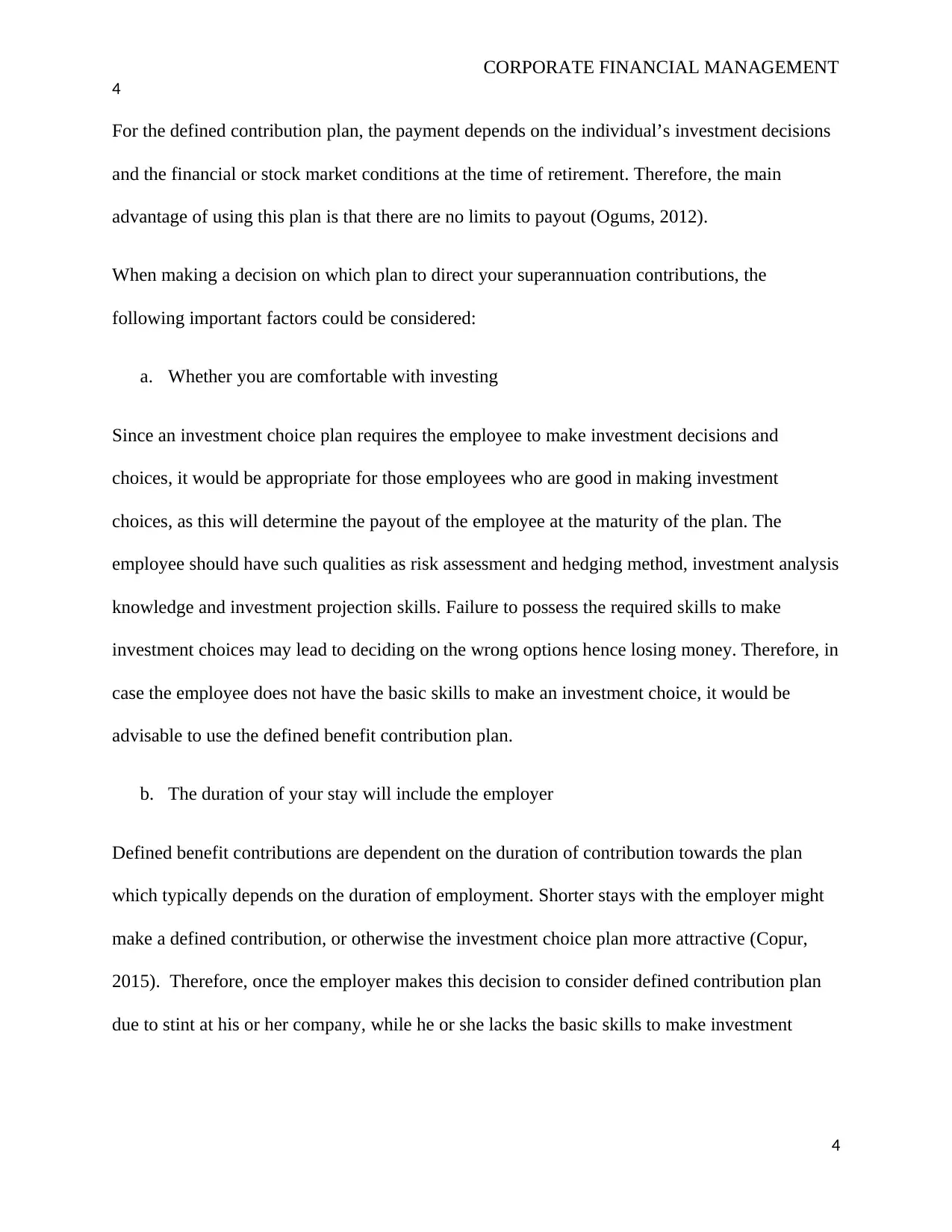
CORPORATE FINANCIAL MANAGEMENT
4
For the defined contribution plan, the payment depends on the individual’s investment decisions
and the financial or stock market conditions at the time of retirement. Therefore, the main
advantage of using this plan is that there are no limits to payout (Ogums, 2012).
When making a decision on which plan to direct your superannuation contributions, the
following important factors could be considered:
a. Whether you are comfortable with investing
Since an investment choice plan requires the employee to make investment decisions and
choices, it would be appropriate for those employees who are good in making investment
choices, as this will determine the payout of the employee at the maturity of the plan. The
employee should have such qualities as risk assessment and hedging method, investment analysis
knowledge and investment projection skills. Failure to possess the required skills to make
investment choices may lead to deciding on the wrong options hence losing money. Therefore, in
case the employee does not have the basic skills to make an investment choice, it would be
advisable to use the defined benefit contribution plan.
b. The duration of your stay will include the employer
Defined benefit contributions are dependent on the duration of contribution towards the plan
which typically depends on the duration of employment. Shorter stays with the employer might
make a defined contribution, or otherwise the investment choice plan more attractive (Copur,
2015). Therefore, once the employer makes this decision to consider defined contribution plan
due to stint at his or her company, while he or she lacks the basic skills to make investment
4
4
For the defined contribution plan, the payment depends on the individual’s investment decisions
and the financial or stock market conditions at the time of retirement. Therefore, the main
advantage of using this plan is that there are no limits to payout (Ogums, 2012).
When making a decision on which plan to direct your superannuation contributions, the
following important factors could be considered:
a. Whether you are comfortable with investing
Since an investment choice plan requires the employee to make investment decisions and
choices, it would be appropriate for those employees who are good in making investment
choices, as this will determine the payout of the employee at the maturity of the plan. The
employee should have such qualities as risk assessment and hedging method, investment analysis
knowledge and investment projection skills. Failure to possess the required skills to make
investment choices may lead to deciding on the wrong options hence losing money. Therefore, in
case the employee does not have the basic skills to make an investment choice, it would be
advisable to use the defined benefit contribution plan.
b. The duration of your stay will include the employer
Defined benefit contributions are dependent on the duration of contribution towards the plan
which typically depends on the duration of employment. Shorter stays with the employer might
make a defined contribution, or otherwise the investment choice plan more attractive (Copur,
2015). Therefore, once the employer makes this decision to consider defined contribution plan
due to stint at his or her company, while he or she lacks the basic skills to make investment
4
Paraphrase This Document
Need a fresh take? Get an instant paraphrase of this document with our AI Paraphraser
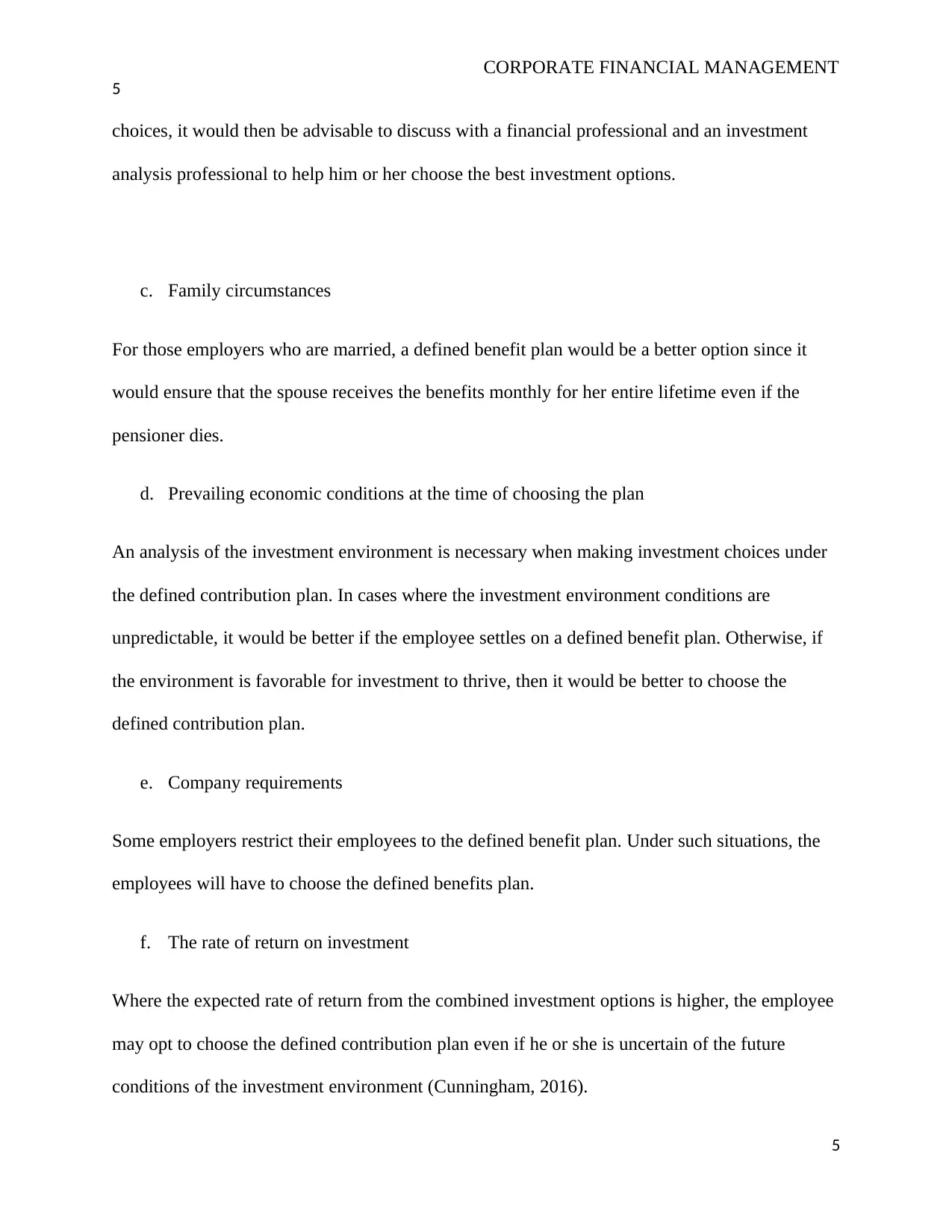
CORPORATE FINANCIAL MANAGEMENT
5
choices, it would then be advisable to discuss with a financial professional and an investment
analysis professional to help him or her choose the best investment options.
c. Family circumstances
For those employers who are married, a defined benefit plan would be a better option since it
would ensure that the spouse receives the benefits monthly for her entire lifetime even if the
pensioner dies.
d. Prevailing economic conditions at the time of choosing the plan
An analysis of the investment environment is necessary when making investment choices under
the defined contribution plan. In cases where the investment environment conditions are
unpredictable, it would be better if the employee settles on a defined benefit plan. Otherwise, if
the environment is favorable for investment to thrive, then it would be better to choose the
defined contribution plan.
e. Company requirements
Some employers restrict their employees to the defined benefit plan. Under such situations, the
employees will have to choose the defined benefits plan.
f. The rate of return on investment
Where the expected rate of return from the combined investment options is higher, the employee
may opt to choose the defined contribution plan even if he or she is uncertain of the future
conditions of the investment environment (Cunningham, 2016).
5
5
choices, it would then be advisable to discuss with a financial professional and an investment
analysis professional to help him or her choose the best investment options.
c. Family circumstances
For those employers who are married, a defined benefit plan would be a better option since it
would ensure that the spouse receives the benefits monthly for her entire lifetime even if the
pensioner dies.
d. Prevailing economic conditions at the time of choosing the plan
An analysis of the investment environment is necessary when making investment choices under
the defined contribution plan. In cases where the investment environment conditions are
unpredictable, it would be better if the employee settles on a defined benefit plan. Otherwise, if
the environment is favorable for investment to thrive, then it would be better to choose the
defined contribution plan.
e. Company requirements
Some employers restrict their employees to the defined benefit plan. Under such situations, the
employees will have to choose the defined benefits plan.
f. The rate of return on investment
Where the expected rate of return from the combined investment options is higher, the employee
may opt to choose the defined contribution plan even if he or she is uncertain of the future
conditions of the investment environment (Cunningham, 2016).
5
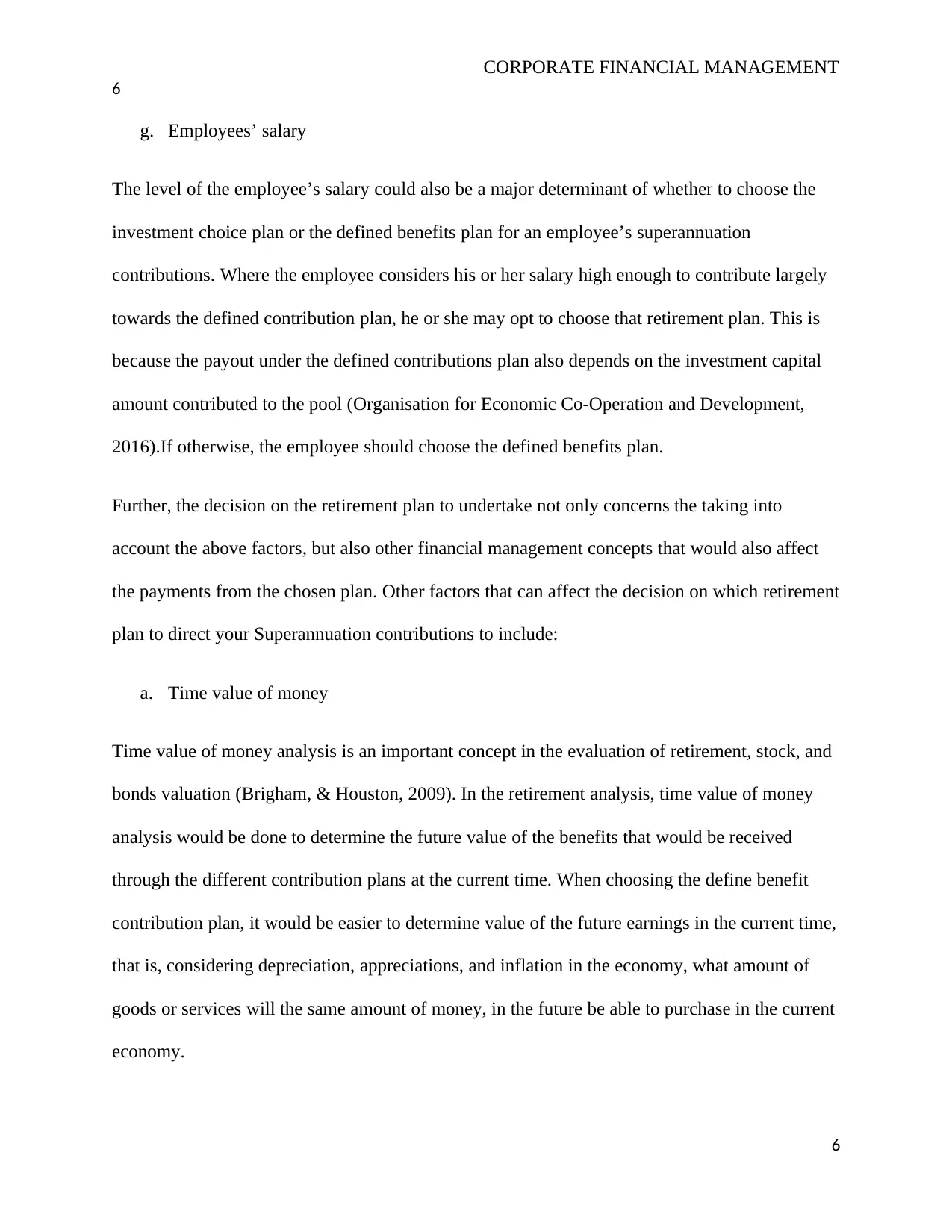
CORPORATE FINANCIAL MANAGEMENT
6
g. Employees’ salary
The level of the employee’s salary could also be a major determinant of whether to choose the
investment choice plan or the defined benefits plan for an employee’s superannuation
contributions. Where the employee considers his or her salary high enough to contribute largely
towards the defined contribution plan, he or she may opt to choose that retirement plan. This is
because the payout under the defined contributions plan also depends on the investment capital
amount contributed to the pool (Organisation for Economic Co-Operation and Development,
2016).If otherwise, the employee should choose the defined benefits plan.
Further, the decision on the retirement plan to undertake not only concerns the taking into
account the above factors, but also other financial management concepts that would also affect
the payments from the chosen plan. Other factors that can affect the decision on which retirement
plan to direct your Superannuation contributions to include:
a. Time value of money
Time value of money analysis is an important concept in the evaluation of retirement, stock, and
bonds valuation (Brigham, & Houston, 2009). In the retirement analysis, time value of money
analysis would be done to determine the future value of the benefits that would be received
through the different contribution plans at the current time. When choosing the define benefit
contribution plan, it would be easier to determine value of the future earnings in the current time,
that is, considering depreciation, appreciations, and inflation in the economy, what amount of
goods or services will the same amount of money, in the future be able to purchase in the current
economy.
6
6
g. Employees’ salary
The level of the employee’s salary could also be a major determinant of whether to choose the
investment choice plan or the defined benefits plan for an employee’s superannuation
contributions. Where the employee considers his or her salary high enough to contribute largely
towards the defined contribution plan, he or she may opt to choose that retirement plan. This is
because the payout under the defined contributions plan also depends on the investment capital
amount contributed to the pool (Organisation for Economic Co-Operation and Development,
2016).If otherwise, the employee should choose the defined benefits plan.
Further, the decision on the retirement plan to undertake not only concerns the taking into
account the above factors, but also other financial management concepts that would also affect
the payments from the chosen plan. Other factors that can affect the decision on which retirement
plan to direct your Superannuation contributions to include:
a. Time value of money
Time value of money analysis is an important concept in the evaluation of retirement, stock, and
bonds valuation (Brigham, & Houston, 2009). In the retirement analysis, time value of money
analysis would be done to determine the future value of the benefits that would be received
through the different contribution plans at the current time. When choosing the define benefit
contribution plan, it would be easier to determine value of the future earnings in the current time,
that is, considering depreciation, appreciations, and inflation in the economy, what amount of
goods or services will the same amount of money, in the future be able to purchase in the current
economy.
6
⊘ This is a preview!⊘
Do you want full access?
Subscribe today to unlock all pages.

Trusted by 1+ million students worldwide
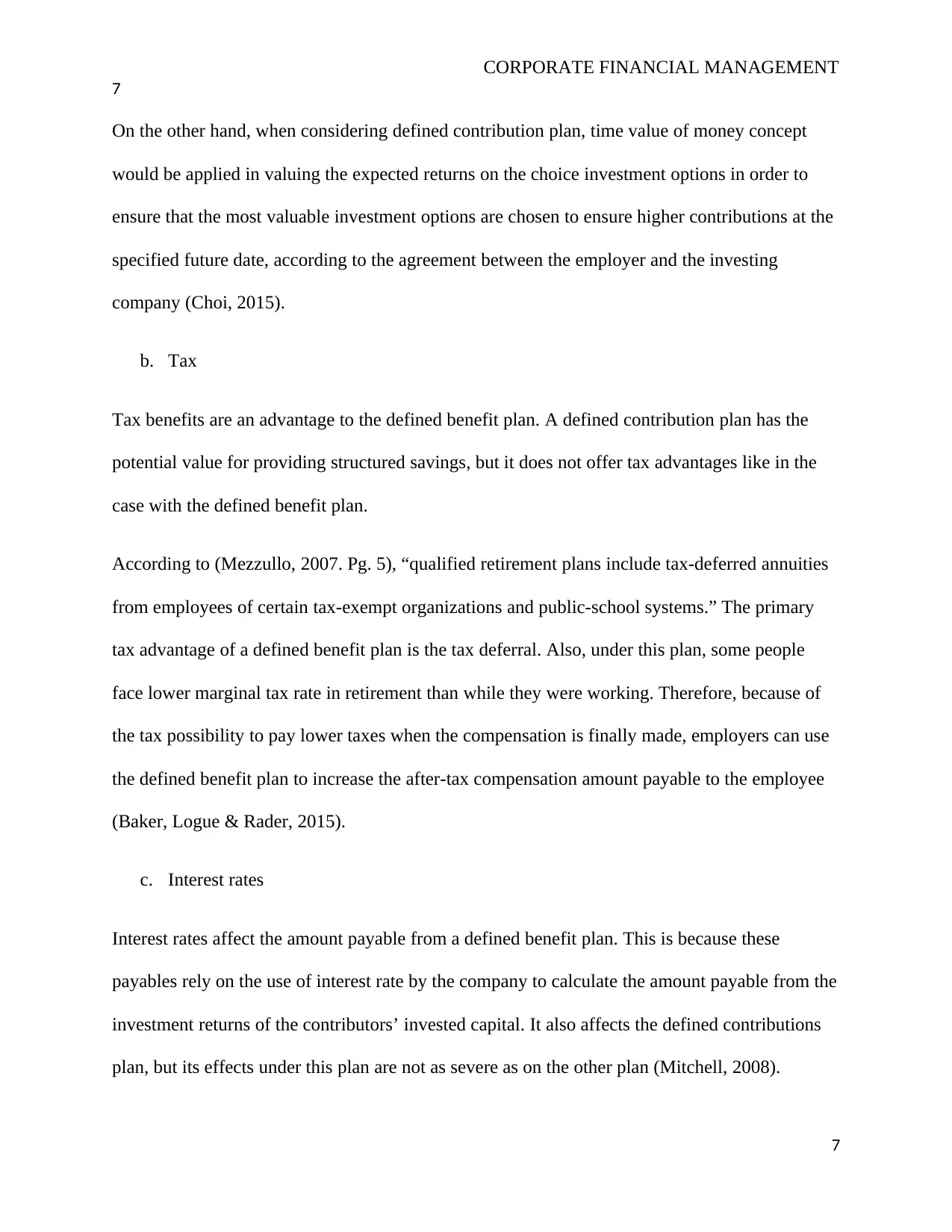
CORPORATE FINANCIAL MANAGEMENT
7
On the other hand, when considering defined contribution plan, time value of money concept
would be applied in valuing the expected returns on the choice investment options in order to
ensure that the most valuable investment options are chosen to ensure higher contributions at the
specified future date, according to the agreement between the employer and the investing
company (Choi, 2015).
b. Tax
Tax benefits are an advantage to the defined benefit plan. A defined contribution plan has the
potential value for providing structured savings, but it does not offer tax advantages like in the
case with the defined benefit plan.
According to (Mezzullo, 2007. Pg. 5), “qualified retirement plans include tax-deferred annuities
from employees of certain tax-exempt organizations and public-school systems.” The primary
tax advantage of a defined benefit plan is the tax deferral. Also, under this plan, some people
face lower marginal tax rate in retirement than while they were working. Therefore, because of
the tax possibility to pay lower taxes when the compensation is finally made, employers can use
the defined benefit plan to increase the after-tax compensation amount payable to the employee
(Baker, Logue & Rader, 2015).
c. Interest rates
Interest rates affect the amount payable from a defined benefit plan. This is because these
payables rely on the use of interest rate by the company to calculate the amount payable from the
investment returns of the contributors’ invested capital. It also affects the defined contributions
plan, but its effects under this plan are not as severe as on the other plan (Mitchell, 2008).
7
7
On the other hand, when considering defined contribution plan, time value of money concept
would be applied in valuing the expected returns on the choice investment options in order to
ensure that the most valuable investment options are chosen to ensure higher contributions at the
specified future date, according to the agreement between the employer and the investing
company (Choi, 2015).
b. Tax
Tax benefits are an advantage to the defined benefit plan. A defined contribution plan has the
potential value for providing structured savings, but it does not offer tax advantages like in the
case with the defined benefit plan.
According to (Mezzullo, 2007. Pg. 5), “qualified retirement plans include tax-deferred annuities
from employees of certain tax-exempt organizations and public-school systems.” The primary
tax advantage of a defined benefit plan is the tax deferral. Also, under this plan, some people
face lower marginal tax rate in retirement than while they were working. Therefore, because of
the tax possibility to pay lower taxes when the compensation is finally made, employers can use
the defined benefit plan to increase the after-tax compensation amount payable to the employee
(Baker, Logue & Rader, 2015).
c. Interest rates
Interest rates affect the amount payable from a defined benefit plan. This is because these
payables rely on the use of interest rate by the company to calculate the amount payable from the
investment returns of the contributors’ invested capital. It also affects the defined contributions
plan, but its effects under this plan are not as severe as on the other plan (Mitchell, 2008).
7
Paraphrase This Document
Need a fresh take? Get an instant paraphrase of this document with our AI Paraphraser
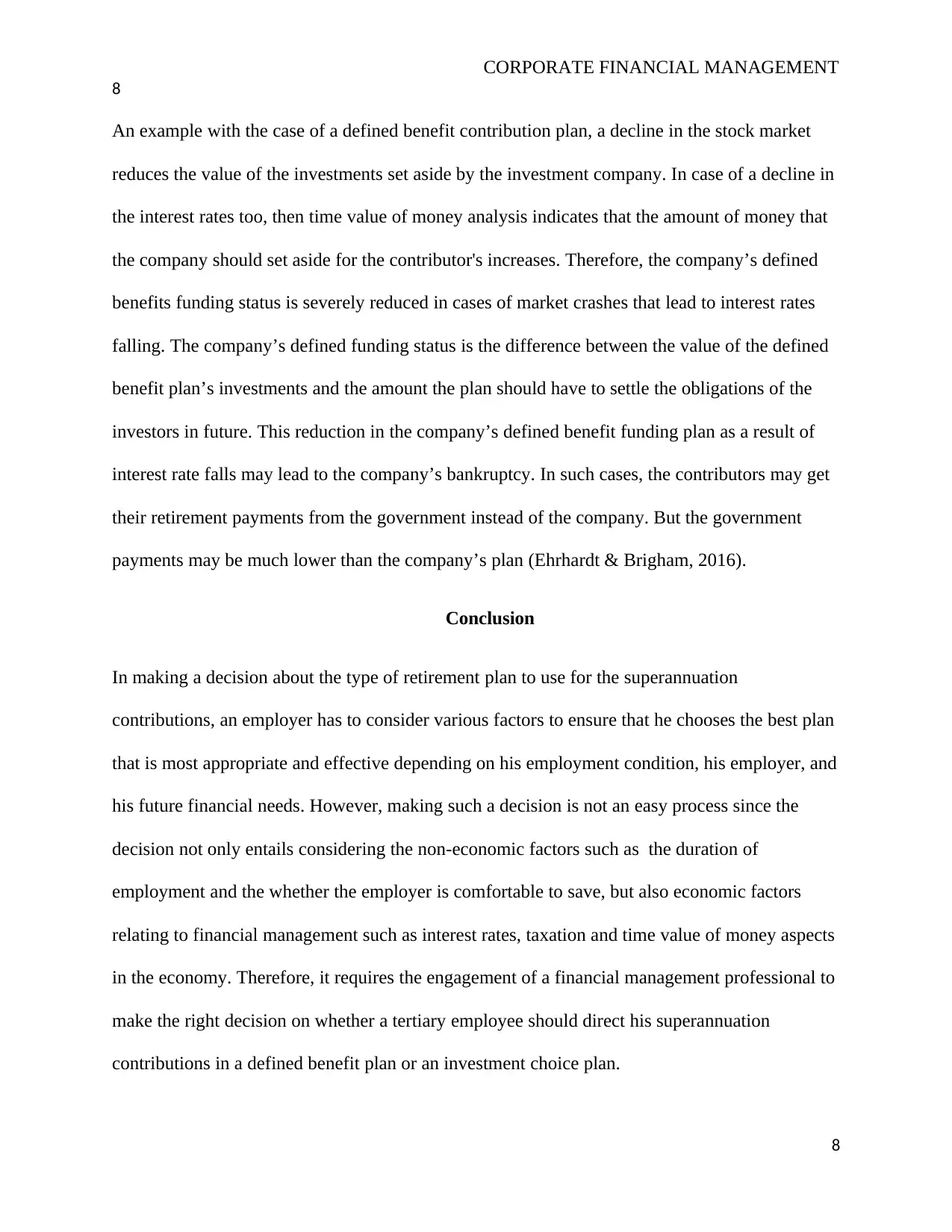
CORPORATE FINANCIAL MANAGEMENT
8
An example with the case of a defined benefit contribution plan, a decline in the stock market
reduces the value of the investments set aside by the investment company. In case of a decline in
the interest rates too, then time value of money analysis indicates that the amount of money that
the company should set aside for the contributor's increases. Therefore, the company’s defined
benefits funding status is severely reduced in cases of market crashes that lead to interest rates
falling. The company’s defined funding status is the difference between the value of the defined
benefit plan’s investments and the amount the plan should have to settle the obligations of the
investors in future. This reduction in the company’s defined benefit funding plan as a result of
interest rate falls may lead to the company’s bankruptcy. In such cases, the contributors may get
their retirement payments from the government instead of the company. But the government
payments may be much lower than the company’s plan (Ehrhardt & Brigham, 2016).
Conclusion
In making a decision about the type of retirement plan to use for the superannuation
contributions, an employer has to consider various factors to ensure that he chooses the best plan
that is most appropriate and effective depending on his employment condition, his employer, and
his future financial needs. However, making such a decision is not an easy process since the
decision not only entails considering the non-economic factors such as the duration of
employment and the whether the employer is comfortable to save, but also economic factors
relating to financial management such as interest rates, taxation and time value of money aspects
in the economy. Therefore, it requires the engagement of a financial management professional to
make the right decision on whether a tertiary employee should direct his superannuation
contributions in a defined benefit plan or an investment choice plan.
8
8
An example with the case of a defined benefit contribution plan, a decline in the stock market
reduces the value of the investments set aside by the investment company. In case of a decline in
the interest rates too, then time value of money analysis indicates that the amount of money that
the company should set aside for the contributor's increases. Therefore, the company’s defined
benefits funding status is severely reduced in cases of market crashes that lead to interest rates
falling. The company’s defined funding status is the difference between the value of the defined
benefit plan’s investments and the amount the plan should have to settle the obligations of the
investors in future. This reduction in the company’s defined benefit funding plan as a result of
interest rate falls may lead to the company’s bankruptcy. In such cases, the contributors may get
their retirement payments from the government instead of the company. But the government
payments may be much lower than the company’s plan (Ehrhardt & Brigham, 2016).
Conclusion
In making a decision about the type of retirement plan to use for the superannuation
contributions, an employer has to consider various factors to ensure that he chooses the best plan
that is most appropriate and effective depending on his employment condition, his employer, and
his future financial needs. However, making such a decision is not an easy process since the
decision not only entails considering the non-economic factors such as the duration of
employment and the whether the employer is comfortable to save, but also economic factors
relating to financial management such as interest rates, taxation and time value of money aspects
in the economy. Therefore, it requires the engagement of a financial management professional to
make the right decision on whether a tertiary employee should direct his superannuation
contributions in a defined benefit plan or an investment choice plan.
8
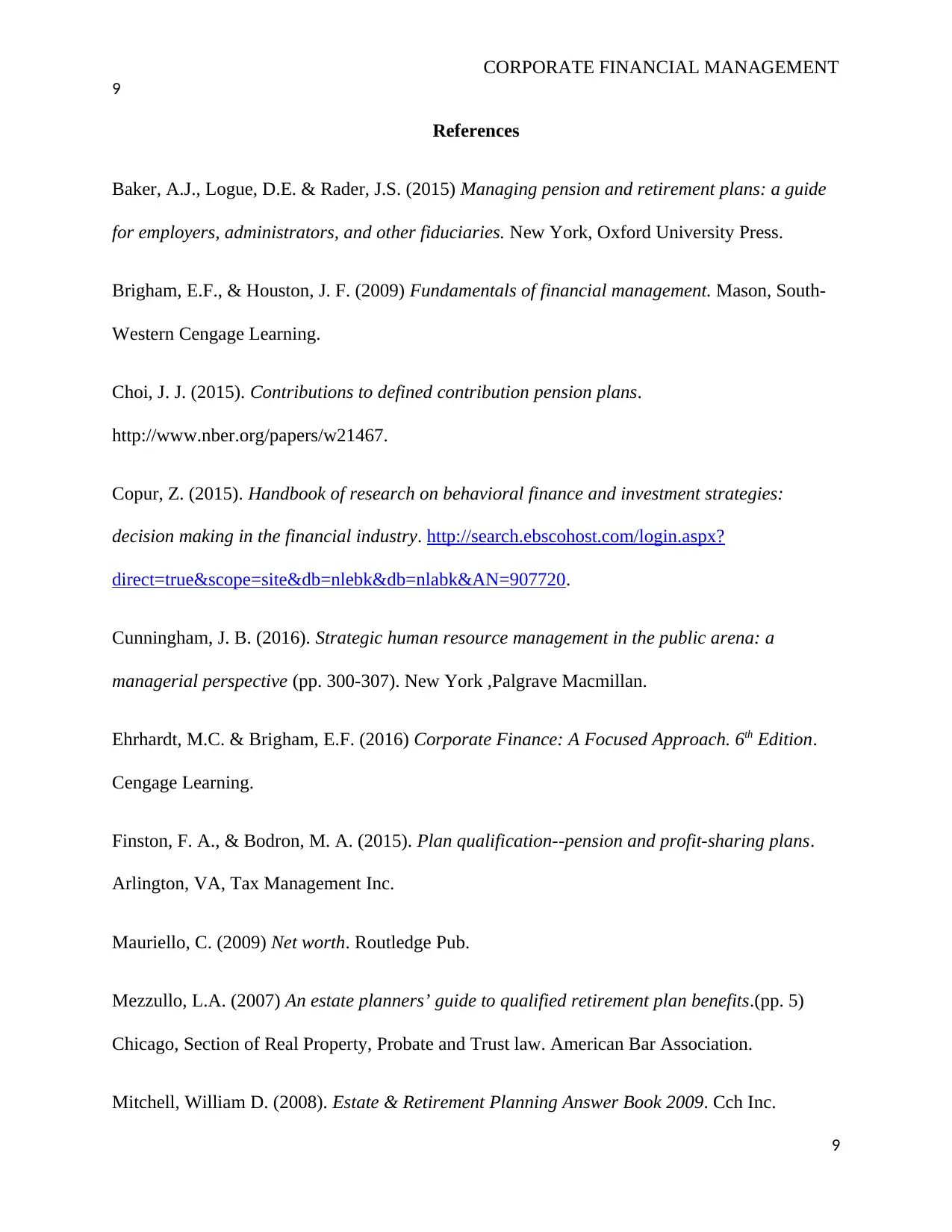
CORPORATE FINANCIAL MANAGEMENT
9
References
Baker, A.J., Logue, D.E. & Rader, J.S. (2015) Managing pension and retirement plans: a guide
for employers, administrators, and other fiduciaries. New York, Oxford University Press.
Brigham, E.F., & Houston, J. F. (2009) Fundamentals of financial management. Mason, South-
Western Cengage Learning.
Choi, J. J. (2015). Contributions to defined contribution pension plans.
http://www.nber.org/papers/w21467.
Copur, Z. (2015). Handbook of research on behavioral finance and investment strategies:
decision making in the financial industry. http://search.ebscohost.com/login.aspx?
direct=true&scope=site&db=nlebk&db=nlabk&AN=907720.
Cunningham, J. B. (2016). Strategic human resource management in the public arena: a
managerial perspective (pp. 300-307). New York ,Palgrave Macmillan.
Ehrhardt, M.C. & Brigham, E.F. (2016) Corporate Finance: A Focused Approach. 6th Edition.
Cengage Learning.
Finston, F. A., & Bodron, M. A. (2015). Plan qualification--pension and profit-sharing plans.
Arlington, VA, Tax Management Inc.
Mauriello, C. (2009) Net worth. Routledge Pub.
Mezzullo, L.A. (2007) An estate planners’ guide to qualified retirement plan benefits.(pp. 5)
Chicago, Section of Real Property, Probate and Trust law. American Bar Association.
Mitchell, William D. (2008). Estate & Retirement Planning Answer Book 2009. Cch Inc.
9
9
References
Baker, A.J., Logue, D.E. & Rader, J.S. (2015) Managing pension and retirement plans: a guide
for employers, administrators, and other fiduciaries. New York, Oxford University Press.
Brigham, E.F., & Houston, J. F. (2009) Fundamentals of financial management. Mason, South-
Western Cengage Learning.
Choi, J. J. (2015). Contributions to defined contribution pension plans.
http://www.nber.org/papers/w21467.
Copur, Z. (2015). Handbook of research on behavioral finance and investment strategies:
decision making in the financial industry. http://search.ebscohost.com/login.aspx?
direct=true&scope=site&db=nlebk&db=nlabk&AN=907720.
Cunningham, J. B. (2016). Strategic human resource management in the public arena: a
managerial perspective (pp. 300-307). New York ,Palgrave Macmillan.
Ehrhardt, M.C. & Brigham, E.F. (2016) Corporate Finance: A Focused Approach. 6th Edition.
Cengage Learning.
Finston, F. A., & Bodron, M. A. (2015). Plan qualification--pension and profit-sharing plans.
Arlington, VA, Tax Management Inc.
Mauriello, C. (2009) Net worth. Routledge Pub.
Mezzullo, L.A. (2007) An estate planners’ guide to qualified retirement plan benefits.(pp. 5)
Chicago, Section of Real Property, Probate and Trust law. American Bar Association.
Mitchell, William D. (2008). Estate & Retirement Planning Answer Book 2009. Cch Inc.
9
⊘ This is a preview!⊘
Do you want full access?
Subscribe today to unlock all pages.

Trusted by 1+ million students worldwide
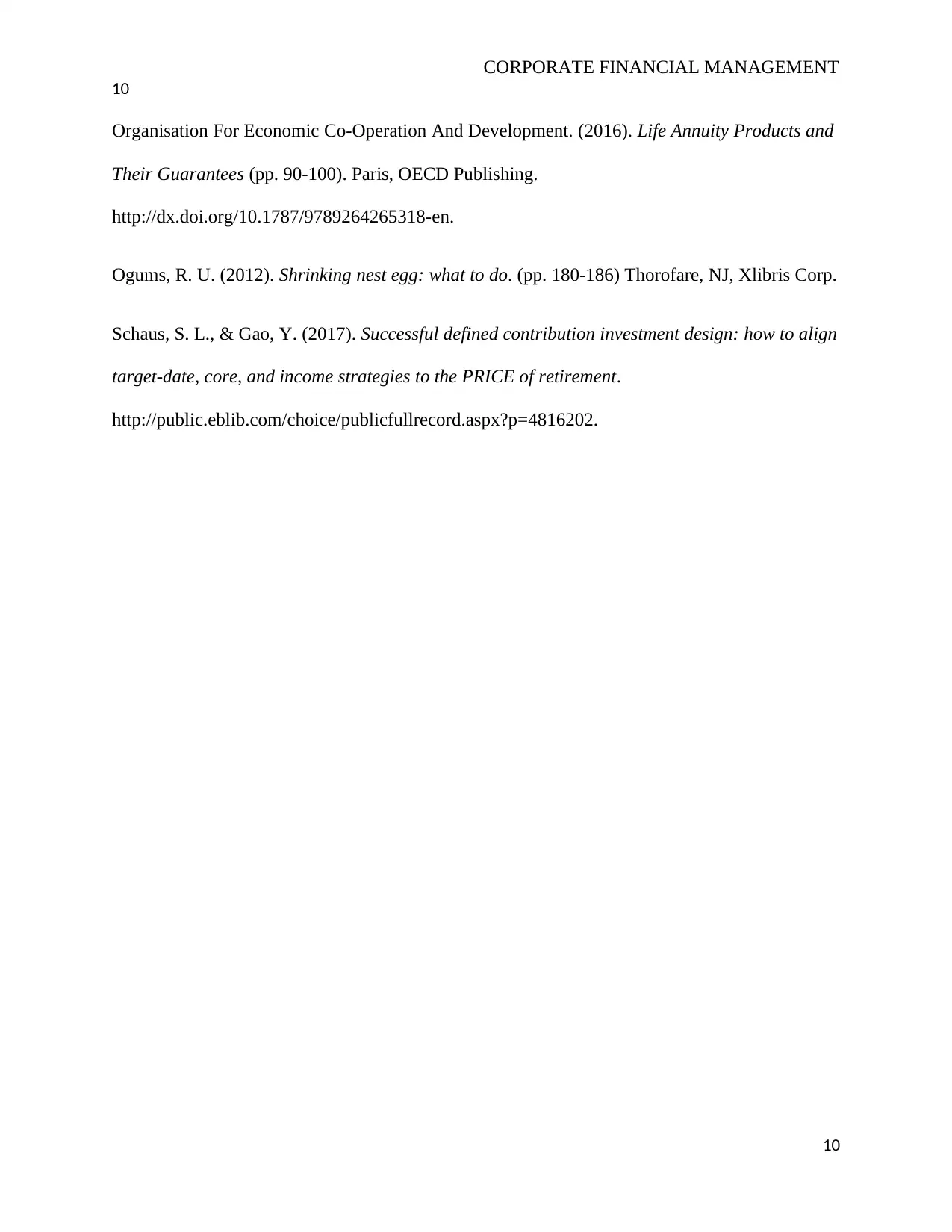
CORPORATE FINANCIAL MANAGEMENT
10
Organisation For Economic Co-Operation And Development. (2016). Life Annuity Products and
Their Guarantees (pp. 90-100). Paris, OECD Publishing.
http://dx.doi.org/10.1787/9789264265318-en.
Ogums, R. U. (2012). Shrinking nest egg: what to do. (pp. 180-186) Thorofare, NJ, Xlibris Corp.
Schaus, S. L., & Gao, Y. (2017). Successful defined contribution investment design: how to align
target-date, core, and income strategies to the PRICE of retirement.
http://public.eblib.com/choice/publicfullrecord.aspx?p=4816202.
10
10
Organisation For Economic Co-Operation And Development. (2016). Life Annuity Products and
Their Guarantees (pp. 90-100). Paris, OECD Publishing.
http://dx.doi.org/10.1787/9789264265318-en.
Ogums, R. U. (2012). Shrinking nest egg: what to do. (pp. 180-186) Thorofare, NJ, Xlibris Corp.
Schaus, S. L., & Gao, Y. (2017). Successful defined contribution investment design: how to align
target-date, core, and income strategies to the PRICE of retirement.
http://public.eblib.com/choice/publicfullrecord.aspx?p=4816202.
10
1 out of 10
Related Documents
Your All-in-One AI-Powered Toolkit for Academic Success.
+13062052269
info@desklib.com
Available 24*7 on WhatsApp / Email
![[object Object]](/_next/static/media/star-bottom.7253800d.svg)
Unlock your academic potential
Copyright © 2020–2025 A2Z Services. All Rights Reserved. Developed and managed by ZUCOL.




